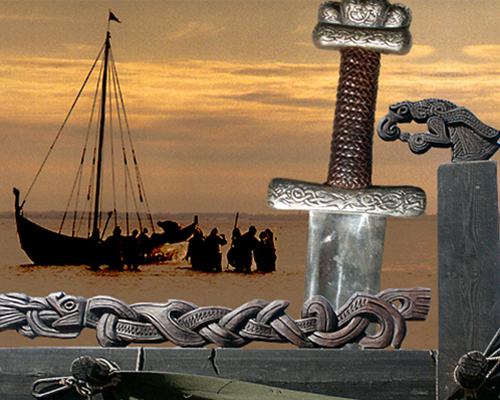| Introduktion

| | Vikingetiden kaldes den periode i nordisk historie, som handler om jernalderens yngste fase. Ca. 700-1100.
Perioden er karakteriseret ved kulturel ensartethed med tætte kulturelle forbindelser mellem de nordiske lande, bl.a. inden for områder som mytologi, byggestil og udsmykning.
|
Vikingetiden kaldes den periode i nordisk historie, som handler om jernalderens yngste fase, ca. 700-1100. Perioden er karakteriseret ved kulturel ensartethed med tætte kulturelle forbindelser mellem de nordiske lande, bl.a. inden for områder som mytologi, byggestil og udsmykning.
Begyndelsen af perioden kendetegnes ved en voldsom ekspansion over store geografiske områder. Mange faktorer har spillet ind. En kraftig befolkningstilvækst i vikingetidens oprindelseslande, dvs. Norge, Danmark og Sverige, er utvivlsomt en af de vigtigste. En forandring, måske i 500 tallet, i den hedenske religion i retning af mere krigeriske guder kan være en anden. Krigeridealet ses f.eks. tydeligt i det faktum, at en mand, som faldt i kamp, straks kom til Odins bolig, Valhalla. En tredje faktor har været den højt udviklede nordiske skibsbyggerkunst og indførelsen af sejlet.
I slutningen af vikingetiden gør kristendommen sig stadig stærkere gældende i Skandinavien. Allerede på et tidligt tidspunkt var europæiske missionærer søgt nordpå, men nu fik de stadig mere opbakning hos de lokale konger og stormænd.
I første omgang blev Jylland og Norge kristnet, fordi disse områder lå tæt ved kristne lande. Norge havde vidtspændende forbindelser med England. I forbindelse med Harald Blåtands erobringer i 970`erne og grundlæggelsen af det, som senere skulle blive et sammenhængende dansk rige, blev kristendommen sandsynligvis indført som en tvangsreligion. Fra Skåne og Norge spredtes den nye lære til Vestergøtland, Østergøtland og Småland. Først i midten og i slutningen af 1100-tallet var svearnes vigtigste område rundt om søen Mælaren og i Uppland blevet kristnet.
Vikingetiden siges normalt at begynde med overfaldet på klosteret Lindisfarne i England år 793, men man kan selvfølgelig ikke datere starten på en periode ud fra et af vikingernes første overfald ude i Europa. Overfaldet er snarere et udtryk for, at man nu var blevet så magtfulde, at man kunne udvide sit interesseområde langt ud over havene. Årstallet stemmer heller ikke overens med arkæologiske fund. Allerede tidligt i 700-tallet kan man f.eks. se en stigning i antallet af rige gravet. På Bornholm har udgravninger f.eks. blotlagt fantastiske pragtgrave fra denne periode. At sætte starten på vikingetiden til 700-tallet kan derfor ikke være helt forkert.
Hvornår sluttede vikingetiden så? Der er mange forskellige årstal at vælge imellem. Problemet er, at ”vikingetiden” aldrig har eksisteret. Perioden er kun noget, man senere har fundet på for at opdele fortiden i mere eller mindre letforståelige perioder. Mange anser Slaget ved Hastings i 1066 for at være en passende afslutning, mens andre mere uklart angiver året 1050, da den danske kongemagt blev tvunget til at opgive forsøgene på at tilbageerobre England.
Problemet er, at tidspunktet for Slaget ved Hastings slet ikke er et skelsættende år for de begivenheder, der samtidig fandt sted hjemme i Skandinavien. I stedet kan man med fordel vælge året 1103. Det år blev Lund ærkebispesæde for hele Norden, idet ærkebiskoppen i Bremen/Hamburg blev tvunget til at afstå nogle af sine magtområder og det år var kristendommen endeligt indført i Skandinavien og med den store dele af den vesteuropæiske kulturarv. |